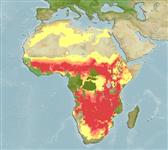Classification / Names
Common names from other countries
Main reference
Size / Weight / Age
Max length : 170 cm TL male/unsexed; (Ref. 40637); common length : 90.0 cm NG male/unsexed; (Ref. 34290); max. published weight: 60.0 kg (Ref. 4537); max. reported age: 15 years (Ref. 94815)
Length at first maturity
Lm 30.8, range 34 - ? cm
Environment
Freshwater; benthopelagic; pH range: 6.5 - 8.0; dH range: 5 - 28; potamodromous (Ref. 51243); depth range 0 - 80 m (Ref. 34291)
Climate / Range
Subtropical; 8°C - 35°C (Ref. 6465), preferred ?; 42°N - 28°S, 17°W - 51°E
Distribution
Africa: almost Pan-Africa, absent from Maghreb, the upper and lower Guinea and the Cape province and probably also Nogal province. Asia: Jordan, Israel, Lebanon, Syria and southern Turkey. Widely introduced to other parts of Africa, Europe and Asia. Several countries report adverse ecological impact after introduction.
Countries | FAO areas | Ecosystems | Occurrences | Introductions
Short description
Dorsal
spines
(total): 0;
Dorsal
soft rays
(total): 61-80;
Anal
spines: 0;
Anal
soft rays: 45 - 65;
Vertebrae: 56 - 63. Diagnosis: body depth 6-8 times in standard length, head 3-3,5 times (Ref. 34290). Head somewhat between rectangular and pointed in dorsal outline; snout broadly rounded; eyes supero-lateral and relatively small (Ref. 248). Teeth on premaxilla and lower jaw small, fine and arranged in several rows; nasal barbels 1/5-1/2 times as long as head in fishes longer than 12 cm, and 1/2-4/5 of head length in smaller individuals; maxillary barbels rarely shorter than head, usually somewhat longer and reaching to a point midway between origin of dorsal fin and insertion of pelvic fins; outer mandibular barbel longer than inner pair (Ref. 34290). Contrary to other Clarias species, Clarias gariepinus has a high number of gill rakers varying from 24-110 (Ref. 248, 34290, 101841), the number increasing with size of the fish; gill rakers long, slender and closely set (Ref. 248, 34290). Distance between occipital process and base of dorsal fin is short; dorsal fin almost reaches caudal fin; anal fin origin closer to caudal fin base than to snout, nearly reaching caudal fin; pelvic fin closer to snout than to caudal fin base; pectoral fin extends from operculum to below 1st dorsal fin rays; pectoral spine robust, serrated only on its outer face, the number of serrations increasing with age; lateral line appears as a small, white line from posterior end of head to middle of caudal fin base; openings to secondary sensory canals clearly marked (Ref. 248).
Colouration: 2 colour patterns can be discerned: uniform and marbled pattern; in uniform pattern, dorsal surface and flanks of body and dorsal parts of pectoral and pelvic fins are generally dark greyish-greenish black, while belly and ventral parts of paired fins are lightly coloured; in marbled pattern, specimens show irregular dark blotches on light coloured background above and laterally, belly and ventral parts of the paired fins are whitish (Ref. 248). Most specimens show pigmentation bands on both sides of lower surface of head (Ref. 248, 81644), but these might be absent (Ref. 101841). A series of light and dark bands may occur on caudal fin; proximal third of caudal fin lightly coloured while other part is dark; occasionally, irregular black spots may occur on caudal fin (Ref. 248). Never an irregular pattern of small white spots on body (Ref. 101841).
IUCN Red List Status (Ref. 115185)
Threat to humans
Potential pest (Ref. 4537)
Human uses
Fisheries: minor commercial; aquaculture: commercial; gamefish: yes
Tools
Special reports
Download XML
Internet sources
Estimates of some properties based on models
Phylogenetic diversity index
PD50 = 0.5000 many relatives (e.g. carps) 0.5 - 2.0 few relatives (e.g. lungfishes)
Trophic Level
3.8 ±0.4 se; Based on diet studies.
Resilience
Medium, minimum population doubling time 1.4 - 4.4 years (K=0.06-0.19; tm=2; Fec > 10,000)
Vulnerability
Very high vulnerability (79 of 100)
Price category
